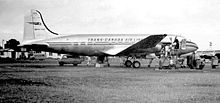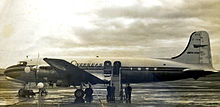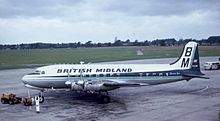- Canadair North Star
-
North Star BOAC DC-4M-4 Argonaut G-ALHS "Astra" at London Airport (Heathrow) in September 1954 Role Passenger and cargo transport Manufacturer Canadair First flight 15 July 1946 Introduction 1946 Retired 1960s (RCAF), 1975 (last civil operator) Primary users Trans-Canada Air Lines
Royal Canadian Air Force
Canadian Pacific Air Lines
BOACProduced 1946 - 1950 Number built 71 Developed from Douglas DC-4 The Canadair North Star was a 1940s Canadian development of the Douglas C-54 / DC-4 aircraft. Instead of radial piston engines found on the Douglas design, Canadair employed Rolls-Royce Merlin engines in order to achieve a 35 mph faster cruising speed. The prototype flew on 15 July 1946 and the type was selected by various airlines as well as by the RCAF. It provided reliable, if noisy, service throughout the 1950s and into the 1960s. Some examples continued to fly into the 1970s as converted cargo aircraft.[1]
Contents
Design and development
Canadair Aircraft Ltd. took over the Canadian Vickers Ltd. operations on 11 November 1944. Besides the existing Consolidated PBY Canso flying patrol boats in production, a development contract to produce a new variant of the Douglas DC-4 transport, was still in effect. The new Canadair DC-4M powered by Rolls-Royce Merlin engines emerged in 1946 as the "North Star." More than just an engine swap, the North Star had the Douglas DC-6 nose, landing gear and fuselage shortened by 80 in (2 metres), DC-4 empennage, rear fuselage, flaps and wing tips, C-54 middle fuselage sections, wing centre and outer wing panel, cabin pressurisation, a standardized cockpit layout and a different electrical system.
Canadair built 71 examples under the designations: North Star, DC-4M, C-4 and C-5. With the exception of the single C-5 (which had the Pratt & Whitney R-2800 engines, as fitted to the Douglas DC-6), these variants were all powered by Rolls-Royce Merlin engines and 51 of the production examples were pressurized.
Operational history
Trans-Canada Air Lines (TCA), the Royal Canadian Air Force (RCAF), Canadian Pacific Airlines (CPA) and British Overseas Airways Corporation (BOAC) were the principal operators of the "North Star", with the CPA examples known as the "Canadair Four" and BOAC examples known as the "Argonaut".
RCAF service
The RCAF North Stars were unpressurized and were used on a wide variety of general transport duties. Like other North Stars, they were also unfortunately notorious for the high level of interior cabin noise caused by the Merlin engines (since the Merlin engine is supercharged using a two-stage geared engine-driven supercharger, its exhaust is not run through a turbocharger, and thus exits the exhaust manifold in high-pressure bursts).
The sole C-5 variant was consequently powered by Pratt & Whitney R-2800 Double Wasp engines (that were considerably quieter).[2] The only C-5 was delivered to the RCAF in 1950, entering service with No. 412 Transport Squadron in Uplands, Ottawa. In RCAF service, the C-5 was specially outfitted for the transportation of VIP passengers. It was then used to transport the Canadian Prime Minister, the Queen, and numerous other dignitaries on various high profile missions. It served faithfully for 17 years, later becoming a crew trainer before being retired and sold in the United States.
North Stars were also employed by 412 Squadron from Ottawa on various VIP transport duties and, overall, the aircraft provided valuable and reliable long range transport services for the RCAF. From 1950 to 1952, during the Korean War, RCAF North Star aircraft were employed ferrying supplies to Korea across the Pacific Ocean. They flew 599 round trips over the Pacific and delivered seven million pounds of cargo and 13,000 personnel on return trips. They flew 1.9 million miles without a fatal crash and outhauled the USAF C-54 on the Korean run. After 1967, the remaining North Stars were assigned to No. 426 Transport Squadron initially deployed to Dorval, Quebec and then to Trenton, Ontario. Gradually, their service life diminished in the 1970s and most were declared surplus.
TCA and BOAC operations
In commercial operations, the North Star had a relatively lengthy career as a passenger airliner. TCA received their fleet of 20 DC-4M-2 North Stars during 1947 and 1948 and operated them on routes within Canada and to the USA until 1961. The North Stars were replaced on TCAs routes to Europe from 1954 onwards by new Super Constellations. In an attempt to deal with constant complaints about noise, T.C.A. engineers developed a special cross-over exhaust that was only a partially successful in reducing noise levels.[2]
BOAC ordered 22 DC-4M-4 aircraft and named them as their "Argonaut class", each aircraft having a classical name prefixed with "A". The Argonauts were delivered between March and November 1949; they flew to South America, Africa, the Middle East and the Far East from London Airport (later Heathrow) until 1960.
Later service
After service with TCA and BOAC, the surplused North Stars and Argonauts had long careers with secondary operators like British Midland, Overseas Aviation and other charter companies. Cargo conversions of available airframes also lengthened the service life of Argonauts and North Stars.CF-UXA,ex-RCAF 17510 was the last DC-4M in airline service, carrying out its final flight 19 June 1975 at Miami, Florida. Despite the onset of jet airliners in the 1950s, the rugged Canadair North Star found a niche in both military and civil use.[1]
Variants
- DC-4M-X North Star: The initial prototype that was later part of the TCA order.
- DC-4M-2/3 North Star: Four-engined civil transport aircraft for Trans Canada Airlines, powered by four Rolls-Royce Merlin 622 piston engines. A total of 20 built for Trans-Canada Airlines. Also known as the North Star M2-3.
- DC-4M-2/4 North Star : Four-engined civil transport aircraft for Trans Canada Airlines, powered by our Rolls-Royce Merlin 624 piston engines. Also known as the North Star M2-4.
- C-54GM North Star Mk 1: Four-engined military transport aircraft for the RCAF, powered by four Rolls-Royce Merlin 620 piston engines. A total of 24 built for RCAF transport use, (the first six actually modified DC-4s).
- North Star Mk 1 ST : North Star Mk 1s converted into passenger transport aircraft.
- DC-4M-1 North Star Mk M1 : Six aircraft operated by Trans Canada Airlines, on loan from the RCAF.
- North Star Mk M1 ST : North Star Mk M1s converted into passenger transport aircraft.
- C-4 Argonaut: A total of 22 built for use by BOAC.
- C-4-1 Canadair Four: Four aircraft identical to BOAC's Argonauts built to Canadian Pacific Airlines specifications.
- North Star C-4-1C : North Star C-4-1s converted into freight or cargo aircraft.
- C-5 North Star: One RCAF VIP transport version powered by four Pratt & Whitney R-2800 radial piston engines.
Operators
Civil operators
- Aden
- Aden Airways
- Canadian Pacific Airlines
- National Research Council
- Trans-Canada Airlines
- World Wide Airways
- Flying Enterprise
- Líneas Aéreas Unidas Mexicanas
- Air Links
- BOAC
- British Midland
- Derby Airways
- Overseas Aviation
- Transglobe Airways
- Aircraft Salvage of Dallas[3]
- Linea Expressa Bolivar
Military operators
Accidents and incidents
- 8 April 1954, a Royal Canadian Air Force Canadair Harvard collided with a Trans-Canada Airlines Canadair North Star over Moose Jaw, Saskatchewan, killing 36 people on the aircraft and one person on the ground.
- 21 September 1955, a British Overseas Airways Corporation Canadair C-4 Argonaut traveling from Rome to Tripoli crashed on its fourth landing attempt in poor visibility and strong winds. A total of 15 of 40 occupants died after the aircraft descended too low, struck trees approximately 1,200 ft short of runway 11, subsequently impacting the terrain. [4]
- 24 June 1956, a BOAC Canadair C-4 Argonaut G-ALHE crashed shortly after taking off from Kano Airport, Nigeria into a thunderstorm, killing 29 0f the 38 passengers and 3 of the seven crew
- 9 December 1956, a Trans-Canada Air Lines Flight 810 crashed into Mount Slesse on a flight from Vancouver to Calgary, killing all 62 people on board the aircraft. Among the dead were five Canadian Football League players, including four members of the Saskatchewan Roughriders and one member of the Winnipeg Blue Bombers, as well as one CFL official on their way home from the annual All-Star game played the previous day at Empire Stadium in Vancouver.
- 27 August 1964 - Former Trans Canada CF-TFQ of Keegan Aviation was damaged beyond repair by Hurricane Leo at Miami, Florida, United States.[5]
- The Stockport Air Disaster occurred when a Canadair C-4 Argonaut aircraft owned by British Midland Airways, registration G-ALHG, and operating a holiday charter flight, crashed near the centre of Stockport, Greater Manchester, United Kingdom on 4 June 1967. Fatalities included 72 of the 84 aboard; 12 others were seriously injured.
Surviving North Stars
A small number of surviving airframes are still in existence including an RCAF C-54GM example (17515 ) which is currently undergoing restoration at the Canada Aviation and Space Museum, Ottawa, Ontario.
Specifications (DC-4-M2 North Star)
General characteristics
- Crew: Seven
- Capacity: 52 First Class passengers, or 62 if operated as an all-Economy Class aircraft or 11,500 lbs (5,216 kg) of cargo
- Length: 94 ft 9½ in (28.89 m)
- Wingspan: 117 ft 6 in (35.81 m)
- Height: 27 ft 6 in (8.38 m)
- Wing area: 1,462 ft² (135.82 m²)
- Empty weight: 43,500 lb (19,731 kg)
- Loaded weight: 73,000 lb (33,112 kg)
- Powerplant: 4 × Rolls-Royce Merlin 622 piston engines, 1,760 hp (1,313 kW) each
Performance
- Maximum speed: 307 knots (353 mph, 568 km/h)
- Cruise speed: 282 knots (325 mph, 523 km/h)
- Range: . (6 212 km.)
- Service ceiling: 36,000 ft (10,970 m)
See also
- Related development
- Aircraft of comparable role, configuration and era
- Related lists
- List of airliners
- List of aircraft
References
- Notes
- ^ a b Milberry 1982, pp. 213–214.
- ^ a b "Canadair North Star 1 ST." Canada Aviation Museum. Retrieved: 18 March 2011.
- ^ C-54GM N8022L - Airliners.net; Retrieved 6/20/11
- ^ "ASN Aircraft accident Canadair C-4 Argonaut G-ALHL Tripoli-Idris Airport (TIP)." Aviation Safety Network. Retrieved: 26 June 2011.
- ^ Eastwood and Roach 1991, pp. 57–58.
- Bibliography
- Eastwood, Tony and John Roach. Piston Engine Airliner Production List. West Drayton, UK: Aviation Hobby Shop, 1991. ISBN 0-907178-37-5.
- Milberry, Larry. The Canadair North Star. Toronto: CANAV Books, 1982. ISBN 0-07-549965-7.
- Pickler, Ron and Larry Milberry. Canadair: The First 50 Years. Toronto: CANAV Books, 1995. ISBN 0-921022-07-7.
External links
Douglas and McDonnell Douglas airliners Piston-engined Jet-engined Not developed DC-7 (Globemaster) · DC-7D · DC-8 (piston airliner) · DC-9 (Model 2067) · MD-91X/-92X/-94X · MD-12/-XX
Canadair aircraft models Unmanned Piston-engined North Star · CL-16 · CL-28 · CL-66 · CL-215
Turboprops Jets CL-13 · CL-30 · CL-41 · CL-52 · CL-90 · CF-5 · CL-600/CL-601/CL-604 · CRJ
Lists relating to aviation General Aircraft (manufacturers) · Aircraft engines (manufacturers) · Airlines (defunct) · Airports · Civil authorities · Museums · Registration prefixes · Rotorcraft (manufacturers) · TimelineMilitary Accidents/incidents Records Categories:- Canadian airliners 1940–1949
- Canadair aircraft
Wikimedia Foundation. 2010.




